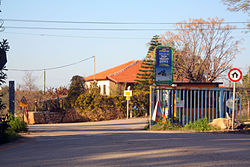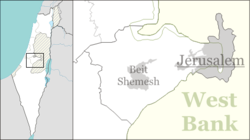Agur, Israel
|
Agur עגור |
|
|---|---|
 |
|
| Coordinates: 31°41′54.83″N 34°54′38.71″E / 31.6985639°N 34.9107528°ECoordinates: 31°41′54.83″N 34°54′38.71″E / 31.6985639°N 34.9107528°E | |
| District | Jerusalem |
| Council | Mateh Yehuda |
| Affiliation | Moshavim Movement |
| Founded | 1950 |
| Founded by | Kurdish Jews |
| Population (2015) | 521 |
| Name meaning | Crane |
Agur (Hebrew: עָגוּר, lit. Crane), pronounced ʻA[dʒ]oor, is a moshav in central Israel. Located near Beit Shemesh, it falls under the jurisdiction of Mateh Yehuda Regional Council. In 2015 it had a population of 521.
In June 1950, the first people brought to the abandoned village of 'Ajjur by the Jewish Agency were Yemenite Jewish émigrés, who were employed by the Jewish National Fund in planting trees, along with a group of young, enlisted servicemen known as the "Young Battalion" (Gadna) from Rehovot who accompanied them. The abandoned Arab village was in dire neglect, with thorn-hedges and briers impeding access to the village, although to their great delight they found stone houses still intact, olive groves, vineyards and fig trees. The new settlers pitched their tents, spending their first summer in tents, until there could be built for them more permanent structures at the foot of the stone houses. A grocery shop, infirmary and armor cache were also built by them in their new village. The Rabbi of the village had built a ritual bath (Heb. mikveh) for purification purposes required in Jewish orthodox law, and was entrusted with the education of the children of the village, but by July of 1951 he had failed to procure financial assistance from the government for his part in educating the youth. In addition to this, the strain on the Yemenite immigrants was great because of the cultural differences between the two groups who had come to settle in the same village. The government at this time had sought to separate the two diametrically different groups one from the other, and to resettle the one group elsewhere, but they refused to move to the place suggested to them, asking instead to be given housing in the central part of the country, in the plains. The government, in an effort to coerce them to move to the site offered to them, and seeing their refusal to move, withheld from them work and subsequent pay. By 1952, out of a total of 250 families who were settled initially on the village, there remained only 45 families. Most had left the village and moved to the Transit Camp (ma'abara) of Zarnuqa, near Rehovot.
...
Wikipedia

